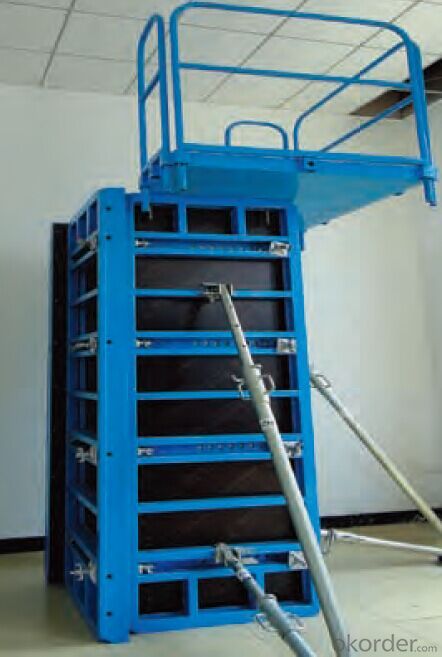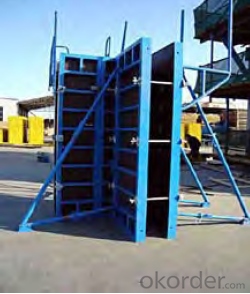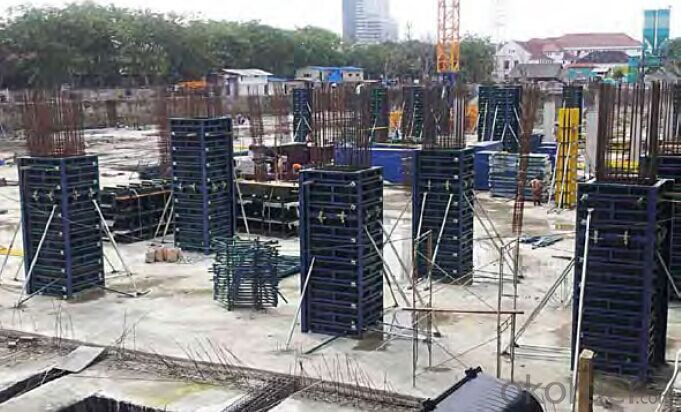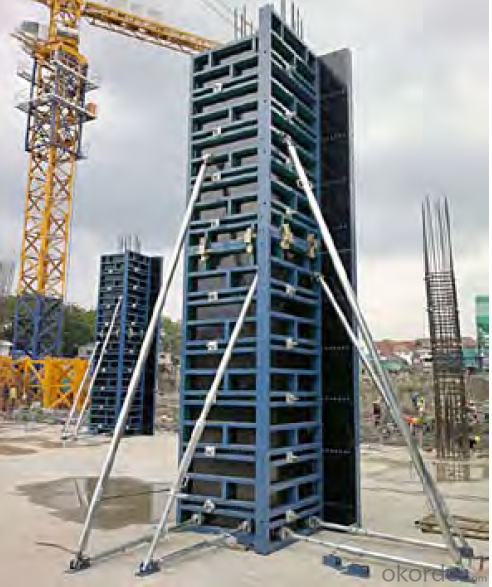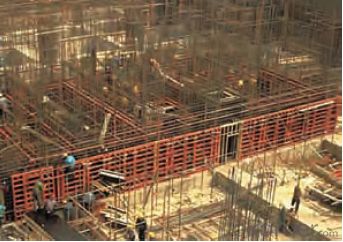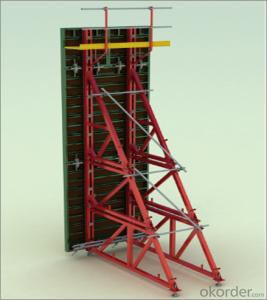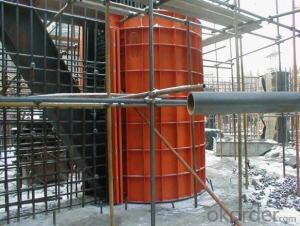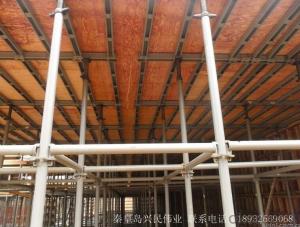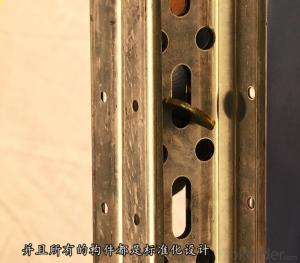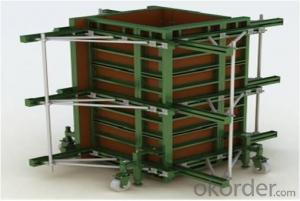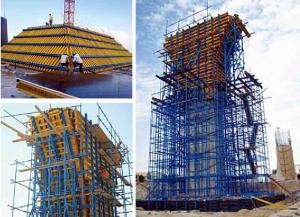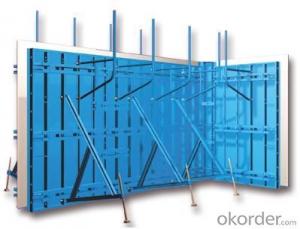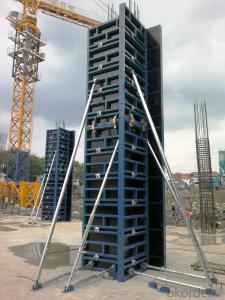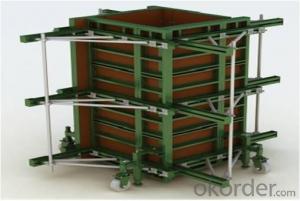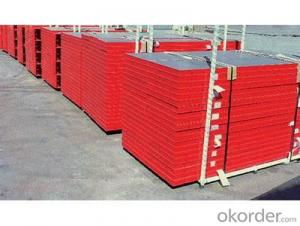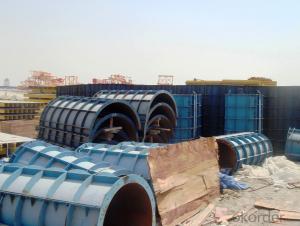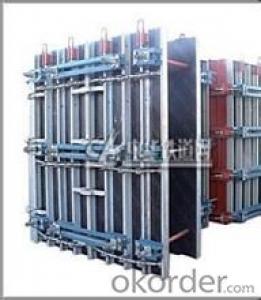Steel Frame Formwork of Convenient and Fast Operation
- Loading Port:
- Shanghai
- Payment Terms:
- TT OR LC
- Min Order Qty:
- 1 m²
- Supply Capability:
- 100000000 m²/month
OKorder Service Pledge
OKorder Financial Service
You Might Also Like
1. Structure of Steel Frame Formwork GK120
There is a prizing part designed in the corner, which can help to position and remove formwork easily.
The plywood is screwed on from the back when connecting frame and plywood, so the surface of the finished concrete is perfect.
The formwork series are a complete system with a full set of accessories, and can be set up flexibly according to project demand.
2. Main Features of Steel Frame Formwork GK120
Light weight
High strength
High standardized system
Easy connection with adjustable steel clamp
Convenient and fast corner formwork
Flexible to assemble and application
3. Steel Frame Formwork GK120 Images
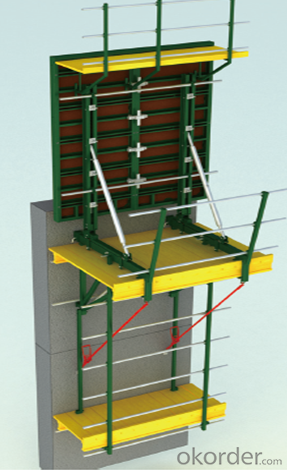
4. Steel Frame Formwork GK120 Specification
-The steel frame formwork is plywood covered with hollow steel. The plywood is 18 mm thick.
-The frame is highly strengthened, and the wall formwork can bear lateral pressure 60 KN/m2 while the column formwork can bear 80 KN/m2.
-As a standardized system, it is flexible to assemble , wood batten can be filled to satisfy the need f of non-standard size.
-The adjustable steel clamp is convenient to use, and can hold tightly.
-There is a prizing part designed in the corner, which can help to position and remove formwork easily.
-The plywood is screwed on from the back when connecting frame and plywood, so the surface of the finished concrete is perfect.
-The formwork series are a complete system with a full set of accessories, and can be set up flexibly according to project demand.
5. FAQ of Steel Frame Formwork GK120
1) What can we do for you?
.We can ensure the quality of the vinyl banner and avoid extra expenses for customers.
.We can provide you the professional design team.
.We can provide fashionable and newest styles for you.
.We can design the artwork for you.
. Please feel free to customize.
2) What promises can be done by us?
. If interested in Steel Frame Formwork GK120, please feel free to write us for any QUOTE.
. If printing required, please advise asap because the whole set need much more time to complete.
. Please DO check goods when courier knocks your door and contact us asap if any issue.
3) What about of our after-sale service?
. Response will be carried out in 24hours after receiving any complain or request.
. Steel Frame Formwork GK120 cost can be refund after order is confirmed.
. If the products are not based on the requirements, there will be the relevant compensations made for you.
4) What about the package and shipping time?
.Packing: As Customer's Requirements
.Shipping: We have various shipping ways for our customers, such as express which including TNT, DHL, FEDEX, UPS, EMS, etc. ; by air/ sea, and we are VIP of these express.
.Shipping time:
Normally small orders, it just 10-15 business days to arrive your hand; When comes to the customs declaration, it may need 7 days.
Other mass qty of Steel Frame Formwork GK120, we send them out by sea or by air to sea port or air port to save some shipping freight for our customers. By ocean, it may need 45~60days, by air, it may need 25~40days.
- Q: How does steel frame formwork contribute to the overall cost-effectiveness of a construction project?
- Steel frame formwork contributes to the overall cost-effectiveness of a construction project in several ways. Firstly, steel frame formwork is durable and reusable, which reduces the need for frequent replacements and saves on material costs. Secondly, it provides a high level of precision and accuracy, resulting in reduced labor and time required for adjustments and corrections. Additionally, steel frame formwork allows for faster construction progress and enables multiple reuses, leading to increased productivity and decreased labor costs. Overall, the use of steel frame formwork minimizes expenses and optimizes efficiency, making it a cost-effective choice for construction projects.
- Q: High standard JGJ3-2002 article 5.2.3: in the vertical load, the frame can be considered when the end of the plastic deformation of the internal force redistribution, the negative moment of the beam multiplied by the amplitude modulation coefficient. The amplitude of the negative moment of the whole frame beam is 0.7 ~ 0.8, and the amplitude modulation coefficient of the negative moment of the frame beam at the end of the beam is expected to be from 0.8 to 0.9...
- The negative moment amplitude modulation coefficient of the steel frame beam should be set 0.7~0.8;A structure consisting of steel beams and steel columns that is capable of bearing vertical and horizontal loads. For industrial and civil buildings with large span or high load.
- Q: How does steel frame formwork contribute to the strength and stability of a concrete structure?
- Steel frame formwork contributes to the strength and stability of a concrete structure by providing a rigid and durable framework for the concrete to be poured into. It ensures accurate alignment and support during the construction process, preventing any deformation or collapse. The steel frame also helps distribute the load evenly across the structure, enhancing its overall strength and stability. Additionally, the use of steel frame formwork allows for efficient construction practices, reducing the risk of errors and improving the quality of the final concrete structure.
- Q: What are the safety precautions for using steel frame formwork in hazardous conditions?
- When using steel frame formwork in hazardous conditions, it is crucial to take several safety precautions. These precautions include ensuring that all personnel involved are properly trained and equipped with appropriate personal protective equipment (PPE) such as hard hats, safety glasses, gloves, and steel-toed boots. Additionally, the formwork should be inspected regularly for any signs of damage or weakness, and any defective components should be replaced immediately. Adequate fall protection systems, such as guardrails and safety nets, should be installed to prevent falls from heights. Lastly, it is important to follow all relevant safety guidelines and regulations specific to the hazardous conditions, such as those related to working in confined spaces or operating heavy machinery.
- Q: What are the different methods of releasing the formwork from the concrete surface?
- There are several methods of releasing formwork from the concrete surface. These include using form release agents, applying a thin layer of oil or grease on the formwork, using water-based release agents, using mechanical methods such as vibrating or tapping the formwork, and using thermal methods such as heating or cooling the formwork. Each method has its own advantages and considerations depending on the specific project and requirements.
- Q: What are the different types of formwork pins used in steel frame formwork systems?
- There are several different types of formwork pins that are commonly used in steel frame formwork systems. These pins are essential for securing the formwork panels and ensuring the stability of the entire structure. Some of the different types of formwork pins used in steel frame formwork systems include: 1. Wedge pins: These are the most commonly used formwork pins and are designed to secure the formwork panels together. They have a wedge shape that allows them to be easily inserted and removed. Wedge pins are typically made of steel and are available in various sizes to accommodate different thicknesses of formwork panels. 2. Flathead pins: These pins have a flat head and are used to hold the formwork panels in place. They are inserted through holes in the formwork panels and secured with a nut or washer on the opposite side. Flathead pins provide a secure connection and are often used in combination with other types of pins for added stability. 3. Connecting pins: These pins are used to connect two or more formwork panels together. They typically have a threaded end that allows them to be screwed into the panels. Connecting pins are commonly used in situations where a tight and secure connection is required, such as when forming corners or curved walls. 4. Tapered pins: These pins have a tapered shape, with one end being larger than the other. They are used to align and secure formwork panels by inserting the larger end into pre-drilled holes in the panels. Tapered pins provide a tight fit and are often used in conjunction with other types of pins for added stability. 5. Snap pins: These pins have a snap-on design that allows them to be easily attached and detached from the formwork panels. They are typically made of plastic or metal and are used in situations where frequent assembly and disassembly of the formwork is required. Overall, the different types of formwork pins used in steel frame formwork systems serve the purpose of securing the formwork panels and ensuring the stability of the entire structure. The specific type of pin used will depend on factors such as the formwork system being used, the thickness of the panels, and the desired level of stability and security.
- Q: What are the different types of scaffolding systems used with steel frame formwork?
- There are several different types of scaffolding systems that are commonly used with steel frame formwork. These systems are designed to provide support and stability to the formwork structure, ensuring the safety of workers and the successful completion of the construction project. One type of scaffolding system used with steel frame formwork is the traditional tube and coupler system. This system consists of vertical tubes, horizontal tubes, and couplers that connect and hold the tubes together. It is a versatile and widely used system that allows for easy adjustment and can be adapted to various heights and configurations. Another common type is the modular scaffolding system, which is also known as the frame scaffolding system. This system consists of prefabricated frames that can be easily assembled and disassembled. It is lightweight and provides a stable and secure platform for workers. Cuplock scaffolding is another popular choice. It is a system that uses vertical standards with a series of cups that lock together to create a secure connection. It is known for its speed of assembly and versatility, as it can be used for both straight and curved structures. Ringlock scaffolding is another commonly used system with steel frame formwork. It features vertical standards with ring-shaped connectors that allow for quick and easy assembly. This system is highly flexible and can be used for various applications, including complex structures. Additionally, there are systems such as H-frame scaffolding, which consists of horizontal and vertical steel frames connected by cross braces, and Kwikstage scaffolding, which is a modular system that uses prefabricated components with wedge connections. Overall, the different types of scaffolding systems used with steel frame formwork offer various advantages and suitability for different construction projects. The choice of system depends on factors such as the project requirements, site conditions, and the preferences of the construction team.
- Q: How does steel frame formwork prevent the formation of concrete bleeding or excess water accumulation?
- Steel frame formwork can prevent the formation of concrete bleeding or excess water accumulation by providing a rigid structure that holds the formwork panels firmly in place. This prevents any movement or deformation of the formwork during the pouring and curing process of the concrete. The steel frame formwork is designed to have tight joints and connections, ensuring that there are no gaps or openings where excess water can escape or accumulate. This prevents the bleeding of water from the concrete, which can weaken the structure and lead to surface defects. Additionally, steel frame formwork is constructed with high-quality materials that are resistant to water absorption. This prevents the formwork from absorbing excess water from the concrete, which could result in an uncontrolled increase in the water-cement ratio and compromise the strength and durability of the concrete. Furthermore, steel frame formwork is typically coated with a layer of anti-adhesive material, such as oil or wax, which prevents the concrete from adhering to the surface of the formwork. This reduces the risk of water accumulation due to the reduced friction between the formwork and the concrete. Overall, the rigid and tightly constructed steel frame formwork provides a secure and watertight enclosure for the concrete, preventing the formation of concrete bleeding or excess water accumulation. This ensures the quality and integrity of the concrete structure, resulting in a durable and long-lasting construction.
- Q: The following is a two storey steel frame to be done above the door of the frame of 9 meters high, with the PKPM model is the use of door type rigid frame, with interlayer, or the lower frame, the upper
- If you use PKPM modeling, you can use the steel frame module calculation, it is best not to separate calculation.
- Q: How does steel frame formwork handle the placement of insulation and waterproofing materials within the concrete structure?
- Steel frame formwork does not directly handle the placement of insulation and waterproofing materials within the concrete structure. Its primary function is to provide a temporary mold for pouring and shaping the concrete. The placement of insulation and waterproofing materials is typically done after the concrete has cured and the formwork is removed.
Send your message to us
Steel Frame Formwork of Convenient and Fast Operation
- Loading Port:
- Shanghai
- Payment Terms:
- TT OR LC
- Min Order Qty:
- 1 m²
- Supply Capability:
- 100000000 m²/month
OKorder Service Pledge
OKorder Financial Service
Similar products
Hot products
Hot Searches






